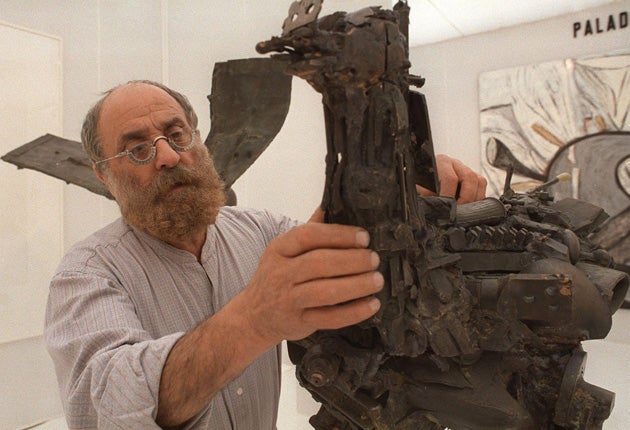On trial: the question of what is modern art
To the uneducated eye, there is very little difference between the work of sculptor César Baldaccini and a block of scrapyard – a characteristic exploited by two French brothers. John Lichfield reports from Paris

The reputation of modern art went on trial in the south of France yesterday. Two brothers are accused in a court in Grasse of faking sculptures, supposedly by the internationally celebrated French artist, César. Two well-known art dealers, one French, one Belgian, are accused of selling the works knowing them to be false.
After eight years of investigations, the one-week trial will inevitably turn into something else: an inquisition into the credulity of art experts and the artless banality of modern art, or at least some modern art.
César Baldaccini, who died in 1998, was celebrated above all for his "compressions" – sculptures made by squashing cars or fridges or other consumer goods into dense metallic squares or oblongs. To the inexpert eye, there was little difference between a César sculpture and a block of compressed metal churned out by a scrapyard. There was equally little difference, it turns out, to the expert eye.
Eric "le Tiec" Piedoie, 55, and his brother, Franck, 52, are accused of making 130 "César" sculptures – mostly metallic "compressions" – and selling them to art galleries at up to €7,600 (£6,942) a piece. Before a TV camera in 2003, Eric Piedoie boasted that he had made at least 1,500 Césars in his garage in Grasse. He gave a brief demonstration, using a child's pedal car and a hydraulic press to turn out a new "César" in a few minutes.
During this week's trial, the Piedoie brothers and four alleged accomplices will argue that they made the Césars in good faith as "imitations" or "representations", rather than fakes. Two well-known art dealers, Guy Pieters and Laurent Strouk, stand accused of selling the sculptures as real Césars for up to €45,000 each. They will insist that they were duped by fake César signatures applied to the works by the Piedoie brothers and by certificates of authenticity supplied by art experts and by César Baldiccini's last girlfriend, Stéphanie Busuttil.
The examining magistrate who conducted an eight-year investigation complained in his written findings of the "lack of seriousness" of several reputable art auction houses which verified the works as real Césars. The public prosecutor pointed out that the French art market was "flooded" with unknown Césars in the three years after the artist's death.
The fact that the artist's family was still disputing his will – and therefore blocking the release of unknown works – "ought to have alerted art professionals, who were taken in by the affair", the prosecution said.
Among the experts who signed certificates of authenticity, in good faith according to the prosecution, was Denyse Durand-Ruel, the woman who edited the definitive catalogue of César's work.
As a result of the scandal, the market for real Césars collapsed for several years and has not yet fully recovered.
César Baldiccini died in December 1998, aged 77. His work, including many more conventional sculptures and collages, is shown in, amongst other places, the Tate Modern in London and the Centre Georges Pompidou in Paris. The French cinema industry's equivalent of the Oscars are called the "Césars" after a bronze "compression" statuette designed by the artist.
César first made his reputation in the 1950s by making sculptures from scrap metal. He adopted this approach, he once explained, because he "could not afford to buy marble". He fashioned complex sculptures of insects from scrap copper tubes and screws, nuts and bolts.
From 1960, he moved to a technique which he called "compression dirigée" or "controlled compression". An art-loving countess made him a present of a brand new Soviet Zil limousine, as used by the members of the Communist politburo. César squashed it completely flat with a hydraullic jack. His "compressions" extended to other cars, pedal cars, refrigerators, paper and jewellery. They were, he said, a "way of disowning the consumer society".
César said that he never planned, or "imagined", his works. Their form suggested itself as he worked upon them. "I have no imagination," he once said.
"Ideas come to me through touching and looking. Without those activities, the brain cannot work."
The lengthy investigation of the fake Césars began by accident in 2001. Police in the south of France searching for stolen art works, including a Chagall and a Magritte, bugged several suspects in a world of high-living, cocaine-taking art lovers and dealers. They stumbled on evidence that Eric Piedoie was flooding the Côte d'Azur with fake Césars.
The appearance of so many unknown works enflamed feelings within César's family and entourage. The artist's wife Rosine Baldaccini and daughter Anna Puységur Baldaccini were disputing his inheritance with his mistress Stéphanie Busuttil. Each side accused the other of selling off works before the dispute was settled in court.
Mme Busuttil was allegedly approached by the Piedoie brothers to sign certificates of authentification for some of their works. She says she did so in good faith: a claim accepted by the prosecution.
In other words, both César's own mistress and the art critic who catalogued his work could not tell authentic "compression" sculptures from fake ones knocked off in a garage. Awkward questions therefore arise. Were César's "compression sculptures" really art? Are the Piedoie brothers con-artists or true, accidental artists themselves?
Join our commenting forum
Join thought-provoking conversations, follow other Independent readers and see their replies
Comments